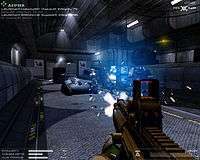NeoTokyo (video game)
| NeoTokyo | |
|---|---|
 NeoTokyo logo | |
| Developer(s) | Studio Radi-8 |
| Composer(s) | Ed Harrison |
| Engine | Source Engine |
| Platform(s) | Microsoft Windows |
| Release |
3 July 2009 (Official Release), 4 July 2014 (Steam Release) |
| Genre(s) | First-person shooter |
| Mode(s) | Multiplayer |
NeoTokyo (stylized as NEOTOKYO°) is a multiplayer first-person shooter total conversion modification of Half-Life 2 in a futuristic world setting, created by American developer Studio Radi-8. Initially released on 3 July 2009 and later re-released for Steam in 4 July 2014, it was voted to be released through Steam Greenlight on 16 October 2012.
Gameplay

NeoTokyo uses a round-based structure similar to Counter-Strike, with players only respawning between rounds. Three character classes are available, differing from each other in speed, health and available weaponry. Each class has a different auxiliary vision mode (light amplification, motion detection and thermal vision) and two out of three classes can cloak.
The gameplay of NeoTokyo is slow-paced and balanced towards the tactical approach, with players generally being able to dispose of each other with a single burst of concentrated fire. The map design reflects this, with most maps giving numerous opportunities for ambushes and flanking.
NeoTokyo has two gametypes: Team Deathmatch (TDM), and Capture The Ghost (CTG), with the majority of maps designed for the latter. Capture The Ghost is similar to one-flag CTF, with two teams competing to pick up the Ghost (a gynoid torso) and carry it to a designated location on the other side of the map. Unlike regular CTF, one team can also win the round by wiping out the other. The Ghost's exact location is always visible to everyone, and the player carrying it can no longer use their primary weapon, but the Ghost allows them to see the locations of opposing team members through walls.
Plot
NeoTokyo is set in Tokyo, approximately 30 years in the future. After the failure of a proposal to alter the Japanese constitution to allow foreign deployment of Japanese soldiers, a military coup d'état is attempted by extreme Japanese nationalist factions in the Japan Self-Defense Forces.[1] In response, the Prime Minister of Japan pools former military intelligence operatives and police officers into a sub-group of the Interior Ministry's National Security Force (NSF), called Group Six, to seek out subsequent coup plotters and uphold the law in both domestic and international soil.[2] Immediately, rumours surface that an unknown faction in the JGSDF's special forces unit "Jinrai" is preparing for another coup attempt against the government. According to the information, the said members of this group are from Special Operations Group 43, fierce ultranationalists determined to succeed with the coup once more.[1] The ensuing strife between these two factions sets the backdrop for the game.[1]
Development
NeoTokyo has been in development since October 2004.[1] Originally designed as a mod for Unreal Tournament 2004 as a deathmatch game with capture points,[3] NeoTokyo's development was later switched to Valve's 2006 Source engine, where the game was remade from scratch and released in 2009.
Ghost in the Shell and Akira were cited as main sources of inspiration behind the game's art style and cyberpunk aesthetic.[3]
The Radi-8 team ceased development of the game soon after its release on the Steam platform, however, remaining fans have attempted multiple times to revive the game with community content. Many are full rewrites or reworks of the game, such as rewriting the game in a newer branch of the Source Engine.[4][5] All known attempts to remake the game have ceased development.
Soundtrack
The soundtrack of NeoTokyo was composed by Ed Harrison, and was described as "haunting" by Jeff Fleming of Game Set Watch. After being recruited from a forum, he also contributed to early sound design before focusing entirely on music. A soundtrack CD was released through CD Baby.[6] He has since self-released the album as a free digital download.[7]
Reception
NeoTokyo was featured in the "Mod World" section of the September 2009 issue of Game Informer.[8] The game has also been featured on gaming website Kotaku, where it was stated that the game "looks completely amazing."[9] It won second place for the 2008 Upcoming Mod of the Year Award.[10]
In February 2010, NeoTokyo placed third in Mod DB's competition for mod of the year.[11]
In August 2012, Glasseater, the lead tester for NeoTokyo,[12] placed an entry for the game in the Steam Greenlight.[13] The game quickly became popular, ranking among the top 15 games on Greenlight. The following October the game was approved, eventually seeing release on the Steam platform on 4 July 2014.
Since its Steam release, NeoTokyo's player counts have declined drastically. Besides during semi-organized events on Friday each week, the game servers will generally be dead at any given time. [14]
References
- 1 2 3 4 "About NeoTokyo". Retrieved 30 April 2010.
- ↑ "NeoTokyo". 1 February 2009. Retrieved 30 April 2010.
- 1 2 "NEOTOKYO° - Humble Beginnings". 17 June 2009. Retrieved 30 April 2010.
- ↑ "Neotokyo Revamp Steam Group".
- ↑ "Neotokyo Revamp github".
- ↑ Fleming, Jeff (26 September 2009). "Interview: Neotokyo's Ed Harrison And His Cyberpunk Soundtrack". Game Set Watch. Retrieved 29 September 2009.
- ↑ "Ed Harrison's soundtrack download page".
- ↑ "Game Informer" (197). September 2009: 94.
- ↑ Mike Fahey (6 July 2009). "Explore NeoTokyo in Half Life 2". Kotaku. Retrieved 30 April 2010.
- ↑ "2008 Upcoming Mod of the Year Winners". 28 February 2009. Retrieved 30 April 2010.
- ↑ Henley (6 February 2010). "Players Choice - Mod of the Year". Retrieved 30 April 2010.
- ↑ "neotokyo team". NeoTokyo HQ. Retrieved 17 October 2012.
- ↑ "NEOTOKYO°'s Greenlight Page". Retrieved 17 October 2012.
- ↑ "NEOTOKYO° - Steam Charts". Steam Charts. Retrieved 11 March 2017.
External links
- Official website
- Neotokyo GSDF (soundtrack pt. 1) on Bandcamp
- Neotokyo NSF (soundtrack pt. 2) on Bandcamp